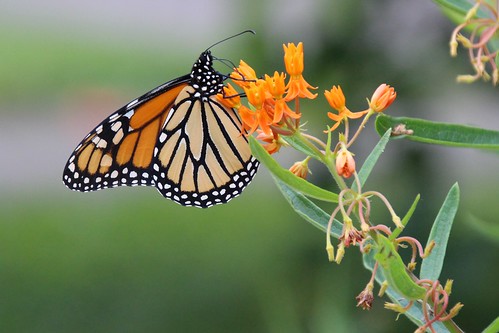Monarchs often fly like they have no idea what they are doing. They flutter up and down and move along in a quirky, unpredictable zig zag pattern, much like an untended toddler in the store. Their erratic flying makes them look drunk, but keeps them mostly safe from flying predators.
Monarchs have some other tricks as well. The milkweed they ate as caterpillars (and all Monarch caterpillars only eat milkweed) contain toxins that stay in their body their entire life. These toxins make any animal with a backbone sick, so most animals leave them alone unless they are spineless.
Spineless? People use that term for people who are weak-willed or cowardly, but the truth is that some of the most vicious mini-predators are spineless. Spiders, ants, bugs and Preying Mantids are all spineless, but they are all incredibly efficient killers.
One of my earliest Monarch encounter memories has to do with a predator when I was around 10 years old. The Monarch Butterfly was flying in its usual erratic path over the field in my backyard when a giant wasp zipped in and grabbed it. The two insects plunged out of sight in the grass below and never emerged. My young brain assumed that the Monarch died and was eaten. That encounter caused a gut emotional reaction of horror that I feel to this day when I think of it.

I will never know what predator took down the Monarch all those years ago. It’s something I would have forgotten if it wasn’t for the Monarchs that I raise each year for Audubon’s Monarch Butterfly Festival. This will be the sixteenth year that I have raised hundreds of caterpillars from egg to adult. Some fly free in the butterfly room at the festival, but most are quietly released into the wild to go about their lives.
My front porch turns into a caterpillar nursery every weekend. There are boxes filled with milkweed and caterpillars in various stages of growth that fill the porch. Butterflies are released onto the hanging plant on the porch, where they slowly flap their wings. These get the cats overly excited as they stare longingly from behind the screen.
The caterpillar nursery inspired questions that don’t have answers. How does the caterpillar feel as it changes into a chrysalis? Is it scared as its whole life is turned upside down? Is it an instinct that feels normal? How do caterpillars know when it is time to wander off and make a chrysalis?
Caterpillars wander off to weave silk onto a plant or other structure that they use to hang off of to make a chrysalis, but no one knows how they know when to do it. Once the silk is woven, they hang upside down from it and shed their caterpillar skin one last time. There is a wiggly green goober underneath that twists and turns as it tightens up into a perfect green chrysalis with gold dots. Does that process hurt? Is that why they wiggle around so much? It is hard to project human consciousness and experience into an insect.
It has to be weird. The caterpillar melts into goo as it turns into a chrysalis and the butterfly forms out of the goo in the week to come. What would that feel like? Can you imagine an uncontrollable urge to hang from your toes and melt to goo? And we think people sometimes have an identity crisis. Imagine walking around with legs before you melted to goo and emerged with wings.

The life of Monarchs is full of oddities. The caterpillar only eats milkweed, and the mom only lays her eggs on milkweed. The egg is so small that the caterpillar’s droppings will be larger than the egg in just a week and a half. Like many newborns, caterpillars spend their time eating, pooping and growing. It only takes a couple of weeks to be large enough to make a chrysalis and move onto the next stage of life.
At this time of year, the caterpillars eat an extra week or so and get extra hefty. These are the Monarchs that will make the one-way flight to the mountains of Mexico, where they will sit quietly in the cool trees and wait for spring.
The Monarch population was down 25% last year on their overwintering grounds. No one can predict what next year’s population will be like until they migrate in September. Locally, Monarchs seem plentiful, but one area with lots of Monarchs doesn’t predict the status of a butterfly whose population spans the continent.
Audubon Community Nature Center builds and nurtures connections between people and nature. ACNC is located just east of Route 62 between Warren and Jamestown. The trails are still open from dawn to dusk as is Liberty, the Bald Eagle. The Nature Center is partially open, including restrooms, the Blue Heron Gift Shop, and some exhibits. More information can be found online at auduboncnc.org or by calling (716) 569-2345.


Recent Comments